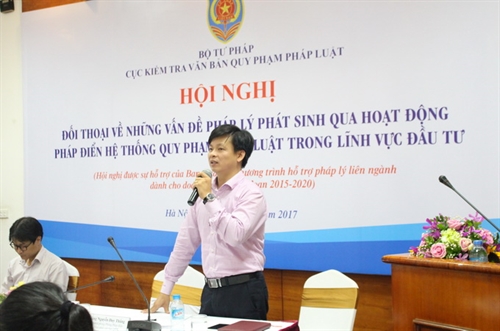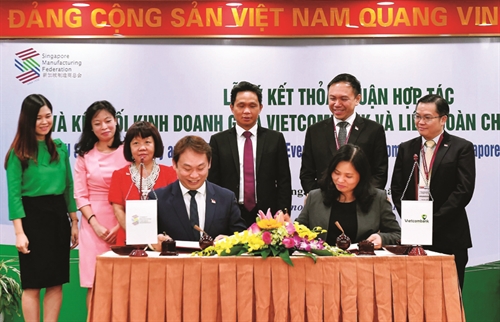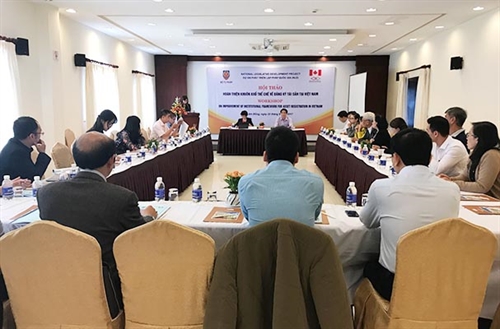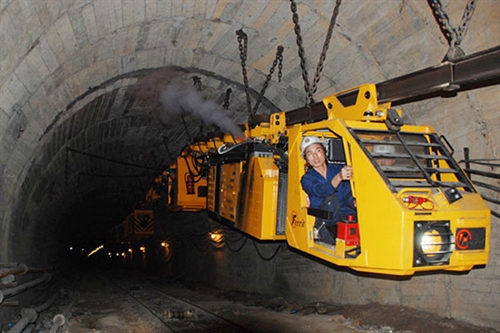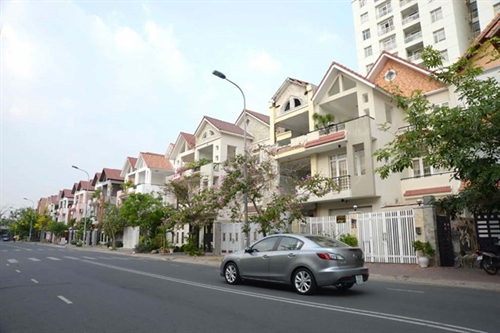As high non-performing loan (NPL) levels affect many credit institutions, particularly financially weak banks, authorities should step in to lead the system-wide response. This article dwells on major solutions to NPLs set forth in a recently approved scheme on banking system restructuring and NPL resolution.
 |
| Vinaconex-Viettel Finance Joint Stock Company is merged into Saigon-Hanoi Commercial Joint Stock Bank under State Bank Governor decision__Photo: Internet |
As reported by the State Bank of Vietnam (SBV), thanks to four years’ implementation of the Scheme on restructuring the system of credit institutions in the 2011-15 period, the system of credit institutions has maintained its stability and safety with a number of weak credit institutions identified for restructuring and the NPL ratio kept under three percent. Despite important progresses recorded in the restructuring of credit institutions and resolution of NPLs, there remain many problems and shortcomings in the system.
In that context, the 14th National Assembly at its third session adopted a resolution on pilot resolution of NPLs of credit institutions. In addition, the Government has recently issued Decision 1058/QD-TTg approving a scheme on restructuring the system of credit institutions associated with the resolution of NPLs in the 2016-20 period.
Objectives of reducing the number of weak credit institutions and keeping NPL ratio below three percent
The new scheme aims to further restructure the system of credit institutions, focusing on substantial resolution of NPLs and restructuring of weak credit institutions with instruments conformable to the market mechanism based on principles of prudence and assurance of depositors’ interests as well as the systemic stability and safety. It is intended to replace weak credit institutions with more prestigious and healthy ones with ensured solvency.
The scheme is designed to bring the proportion of NPLs of credit institutions, loans sold to the Vietnam Asset Management Company (VAMC) and classified loans to under three percent (excluding poorly-performing commercial banks subject to the Government-approved handling measures).
Overall solutions
To achieve the above objectives, the scheme puts forth solutions to restructuring the system of credit institutions associated with the resolution of NPLs in the 2016-20 period, including improvement of the monetary and banking legal framework, mechanisms and policies; raising of financial capability and renovation of business, governance and administration models of credit institutions, intensification and renewal of banking inspection and supervision, and other resolution tools.
Specifically, the improvement of the monetary and banking legal framework, mechanisms and policies covers establishing a complete legal framework for handling and restructuring weak credit institutions. SBV will assume the prime responsibility for studying and submitting to the Government for promulgation a law amending a number of articles of the Law on Credit Institutions and relevant laws and adding regulations on enhanced control of cross-ownership and prevention of abuse of governance, executive and major shareholders’ rights to manipulate credit institutions’ operations.
The central bank will submit to the Government revisions to the Decree permitting foreign investors to purchase shares from Vietnamese credit institutions under which the shareholding rate of foreign investors in each type of credit institution may be higher in conformity with international commitments so as to generate capital sources, promote technology application and take advantage of foreign investors’ governance experience. Foreign investors will be encouraged to take part in handling weak credit institutions.
It will review existing regulations and issue new ones on assurance of safety for banking activities, licensing, inspection, supervision and post-inspection and post-supervision resolution.
Regarding raising of financial capability and renovation of business, governance and administration models of credit institutions, the scheme requires credit institutions to focus on implementing a number or all of the following solutions to improve their financial capability and credit quality, renovate their business, governance and administration models and raise their competitiveness in the 2016-20 period.
Firstly, financial capability and credit quality will be raised by increasing their own capital with better quality to ensure that their charter capital is not lower than the legal capital and maintain the capital adequacy ratio in accordance with law and the international standards.
Credit institutions should work out and implement plans to raise their own capital by issuing additional stocks and increasing capital contributions of domestic and foreign strategic shareholders; increasing capital from annual dividends and retained profits; and issuing convertible bonds and long-term debt instruments. A number of prestigious credit institutions may list their stocks on foreign stock exchanges. By the end of 2020, at least 12-15 commercial banks will successfully meet minimal capital requirements under Basel II standards and at least one commercial bank will be among Asia’s 100 largest banks.
Regarding the control of credit quality, mitigation of NPL build-ups and improvement of asset quality, credit institutions are requested to take the initiative in synchronously and drastically implementing NPL resolution measures, such as urging debt payment; sale and disposal of debts and security assets; initiation of lawsuits against non-performing borrowers; use of risk provisions; and other appropriate measures to help clients overcome difficulties and develop their business and production. In addition, the NPL resolution, especially by the VAMC, under the market mechanism should be further accelerated together with the deployment of measures to inhibit new NPLs and improve credit quality.
Secondly, business models of credit institutions will be renewed into multi-service provision models, no longer depending on credit activities.
Thirdly, the governance and executive capacity and transparency in the operation of credit institutions will be enhanced.
Regarding intensification and renewal of banking inspection and supervision, the scheme emphasizes the necessity to improve the organization and operation of the banking supervision agencies, intensify the coordination and information sharing between SBV and law protection and relevant agencies in the course of inspection and supervision.
The scheme points out to the need for higher capacity of SBV to give early warnings about systemic latent risks and prevent violations of the banking regulations by credit institutions and foreign bank branches.
Under the scheme, renewal of banking supervision work will focus on raising the efficiency of the supervision of micro-safety and macro-safety by using risk supervision tools and methods combined with intensified application of information technology. The supervision must be closely associated with inspection, licensing and issuance of regulations and policies.
The inspection work will be reformed toward enhanced comprehensive inspection of practical operation of credit institutions as legal entities in their observance of the banking policies and laws and control of risks in activities of entities subject to banking inspection and supervision for the future application of risk-based inspection and supervision methods according to international practices and standards.
Credit institution restructuring orientations and solutions
 |
| Vietnam Asset Management Company and Sacombank sign a cooperation agreement on resolution of non-performing loans__Photo: Internet |
The scheme puts forth orientations and solutions to restructure commercial banks in which the State holds more than 50 percent of charter capital, excluding those put for compulsory acquisition. Accordingly, such commercial banks will function as a main force in terms of capital size, market share and capacity to regulate the market and can take the lead in the application of modern banking technology, advanced governance for high business efficiency, safe banking operation and international integration. They will have to actively participate in restructuring weak credit institutions under SBV’s guidance and conduct their business activities under the market mechanism and in accordance with law.
In the meantime, joint-stock commercial banks, finance and financial leasing companies will continue to be restructured in order to quantitatively and qualitatively increase their financial capability for higher operation efficiency and system safety; be able to operate transparently and publicly under the market mechanism; and fully satisfy the banking management and safety standards in compliance with law and international practices.
The scheme heightens the role and responsibility of cooperative banks in regulating capital sources, examining and supervising the use of loans by borrowers and their debt payment ability. Cooperative banks will also have to provide guidance on banking operations and banking skills training, information technology application and assist their member people’s credit funds and handle those facing difficulties and showing signs of unsafe operation.
Synchronous NPL resolution measures
The scheme suggested SBV, ministries, sectors, provincial People’s Committees, credit institutions, VAMC and related organizations and individuals continue to carry out NPL resolution measures under Government Decision 843 dated May 31, 2013.
Credit institutions will review quality and recoverability of loans so as to take appropriate resolution measures, set aside and use more risk provisions for NPL resolution, further reschedule debts and provide financial support to help their clients overcome difficulties. They will also finalize legal files of collateral, collect debts and realize collateral, and mitigate NPL build-ups.
Borrowers are required to consolidate their organizational structures, reorganize their operations, increase their financial and managerial capability, intensify technological application and build their competitiveness. They must proactively work with credit institutions in implementing debt rescheduling plans and remove difficulties hindering their production and business, take the initiative in developing domestic outlets for products and boost exports, and participate in business facilitation programs launched by the Government, ministries, sectors and localities.
SBV, ministries, sectors and localities will continue implementing monetary, credit and banking mechanisms, policies and solutions to facilitate production and business activities, reduce inventories, boost domestic investment and consumption, and develop the realty and securities markets.
The central bank will also intensify the inspection and supervision of credit institutions in the observance of the regulations on credit extension, safe operations and debt classification and setting aside of risk provision. Together with ministries and sectors, it will continue completing the legal framework and enhance the management, inspection and supervision of monetary, banking, securities and insurance activities and operation of state enterprises.
For its part, VAMC will focus on reviewing and classifying borrowers, collateral and debts that it has purchased to determine their recoverability and devise appropriate resolution measures. It will resolutely purchase, sell and dispose of NPLs under the market mechanism and closely coordinate with credit institutions in recovering or rescheduling debts and selling and realizing collateral for purchased NPLs. It may consider providing financial support to borrowers to help recover their production and business and finish their uncompleted projects.- (VLLF)


